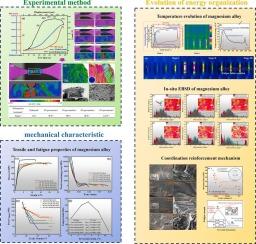Study on the competitive mechanisms of pre-tension strengthening and fatigue damage in AZ31B magnesium alloy
IF 6.8
2区 材料科学
Q1 ENGINEERING, MECHANICAL
引用次数: 0
Abstract
The fatigue strengthening effect of AZ31B magnesium alloy under different degrees of pre-tension deformation was studied. A detailed discussion is presented on the influence of strain on the relationship between fatigue strengthening and damage, from the macroscopic deformation to the microstructural level. The results show that the cross-sectional fatigue strength of the specimen at room temperature first increases and then decreases with the increase of pre-stretch deformation, which is inconsistent with the continuous downward trend of fatigue temperature increase. The 5% pre-tension deformation results in superior fatigue strength for the specimens, with a significant enhancement of 27.77%. The SEM morphology after tensile deformation and fatigue fracture reflects an increase in micro-defects and fatigue damage with the greater pre-tension deformation. Combining in-situ tensile EBSD results on strain hardening and grain orientation differences, the study ultimately analyzed the dialectical relationship between the microstructure and residual stress changes caused by pre-stretching deformation, and the fatigue strengthening and weakening of the specimens, from multiple perspectives. It aims to provide a scientific basis for optimizing the performance of this alloy in practical applications and lay a foundation for further understanding the complexity of its fatigue damage and fracture behavior.

AZ31B镁合金预拉伸强化与疲劳损伤竞争机制研究
研究了AZ31B镁合金在不同预拉伸变形程度下的疲劳强化效果。从宏观变形到微观结构,详细讨论了应变对疲劳强化与损伤关系的影响。结果表明:试件在室温下的截面疲劳强度随预拉伸变形的增大先增大后减小,与疲劳温度升高的持续下降趋势不一致;5%的预拉伸变形使试样的疲劳强度显著提高27.77%。拉伸变形和疲劳断裂后的SEM形貌反映出微缺陷和疲劳损伤随着预拉伸变形的增大而增加。结合原位拉伸EBSD应变硬化和晶粒取向差异的结果,最终从多个角度分析了预拉伸变形引起的显微组织与残余应力变化以及试样疲劳强化和弱化之间的辩证关系。旨在为在实际应用中优化该合金的性能提供科学依据,并为进一步了解其疲劳损伤和断裂行为的复杂性奠定基础。
本文章由计算机程序翻译,如有差异,请以英文原文为准。
求助全文
约1分钟内获得全文
求助全文
来源期刊

International Journal of Fatigue
工程技术-材料科学:综合
CiteScore
10.70
自引率
21.70%
发文量
619
审稿时长
58 days
期刊介绍:
Typical subjects discussed in International Journal of Fatigue address:
Novel fatigue testing and characterization methods (new kinds of fatigue tests, critical evaluation of existing methods, in situ measurement of fatigue degradation, non-contact field measurements)
Multiaxial fatigue and complex loading effects of materials and structures, exploring state-of-the-art concepts in degradation under cyclic loading
Fatigue in the very high cycle regime, including failure mode transitions from surface to subsurface, effects of surface treatment, processing, and loading conditions
Modeling (including degradation processes and related driving forces, multiscale/multi-resolution methods, computational hierarchical and concurrent methods for coupled component and material responses, novel methods for notch root analysis, fracture mechanics, damage mechanics, crack growth kinetics, life prediction and durability, and prediction of stochastic fatigue behavior reflecting microstructure and service conditions)
Models for early stages of fatigue crack formation and growth that explicitly consider microstructure and relevant materials science aspects
Understanding the influence or manufacturing and processing route on fatigue degradation, and embedding this understanding in more predictive schemes for mitigation and design against fatigue
Prognosis and damage state awareness (including sensors, monitoring, methodology, interactive control, accelerated methods, data interpretation)
Applications of technologies associated with fatigue and their implications for structural integrity and reliability. This includes issues related to design, operation and maintenance, i.e., life cycle engineering
Smart materials and structures that can sense and mitigate fatigue degradation
Fatigue of devices and structures at small scales, including effects of process route and surfaces/interfaces.
 求助内容:
求助内容: 应助结果提醒方式:
应助结果提醒方式:


